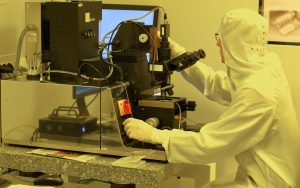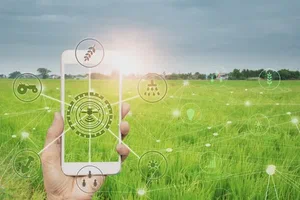What is Nanotechnology?
Over the past ten years, nanotechnology—the study of modifying matter at the atomic and molecular level—has made significant strides, opening up new opportunities in a variety of fields. The impact of nanotechnology is changing industries, from improving healthcare and agriculture to facilitating more environmentally friendly production methods. The significant advantages, uses, and case examples illustrating nanotechnology’s capacity to address urgent global issues are examined in this article.
1. Key Benefits of Nanotechnology

Enhanced Medical Treatments
Nanotechnology in medicine offers groundbreaking ways to treat diseases, improve diagnostics, and enhance vaccine efficacy. Nanoparticles, specifically designed for targeted drug delivery, can release medication precisely where needed, minimizing side effects and improving patient outcomes. This precise targeting has shown promise for cancer treatments and even vaccine delivery systems, which leverage nanoparticles to enhance immune response and increase vaccine efficiency.
Advanced Agricultural Solutions
With the global population rising, food security is a critical concern. Nanotechnology presents innovative agricultural solutions, such as nanosensors that monitor crop health and nanoparticles that deliver nutrients to plants in precise amounts. These advancements support sustainable farming practices, enhance crop yields, and reduce the environmental impact of traditional agriculture.
Environmental Sustainability
Nanotechnology plays a pivotal role in sustainability. By enabling more efficient resource usage, reducing waste, and creating biodegradable materials, nanotechnology is transforming manufacturing practices and promoting environmental health. Additionally, nanomaterials are instrumental in water purification and energy storage, making clean energy sources more viable and accessible.
Innovations in Computing and Electronics
In the tech world, the miniaturization of components has been key to the rapid advancement of computing power. Nanotechnology enables the creation of nanoscale transistors and memory chips that are faster, more efficient, and capable of handling complex data processing tasks. This progress promises a new era of powerful yet compact computing devices, driving future technologies.
2. Applications and Real-World Examples
Vaccine Delivery and Disease Treatment
Example: The COVID-19 pandemic highlighted the importance of efficient vaccine development. Nanoparticle-based vaccines use lipid nanoparticles to deliver mRNA, enhancing the stability and effectiveness of the vaccine. Researchers are exploring ways to apply similar nanotechnologies to other diseases, such as influenza and cancer, aiming to create vaccines that are more powerful and require lower doses.
Food Security and Precision Agriculture

Example: Nanosensors in agriculture allow farmers to monitor soil conditions, crop health, and moisture levels in real time. This data enables precise nutrient delivery, ensuring crops receive only what they need, minimizing resource wastage, and maximizing yield. Nanotechnology’s contributions to agriculture are critical in regions facing water shortages and food insecurity, providing a path to sustainable food production.
Energy Efficiency in Manufacturing
Example: Nanotechnology facilitates the creation of lighter, stronger materials used in various industries, including construction and automotive manufacturing. For example, nanomaterials in car production reduce weight, enhancing fuel efficiency and reducing emissions. In construction, nanomaterials can strengthen concrete, prolonging its life and reducing the need for repairs.
Nanoscale Electronics for Future Technology
Example: Transistors, the building blocks of electronic devices, have become increasingly miniaturized thanks to nanotechnology. By incorporating nanoscale transistors, electronic devices can become more compact and energy-efficient while boosting processing power. This development is essential for creating smaller, faster smartphones, laptops, and wearable technology.
3. Case Studies
Medical Case Study: Vaccine Enhancement
Overview: MIT researchers recently developed a method using metal-organic frameworks (MOFs) to deliver vaccines more effectively. These nanoparticles carry both the antigen and adjuvant, which is essential for stimulating the immune response. In preclinical trials, this approach demonstrated significantly improved immunity at lower doses, indicating a new era of potent vaccines with minimal side effects.
Impact: This nanotechnology-based vaccine delivery method could revolutionize how vaccines are administered, improving accessibility to immunizations in regions with limited healthcare infrastructure. By enhancing the stability and efficacy of vaccines, this technology holds promise for tackling diseases that remain challenging to treat.
Agricultural Case Study: Boosting Crop Yields
Overview: In arid regions of Africa, farmers face extreme weather conditions that threaten crop productivity. Researchers introduced nanoparticles that can deliver nutrients directly to plants, adapting to environmental stresses and enhancing resilience. Additionally, nanosensors allow real-time data collection, optimizing resource allocation and ensuring that crops receive precise amounts of water and fertilizer.
Impact: This nanotechnology application could significantly reduce agricultural resource wastage, increase crop yields, and support sustainable food production in climate-stressed regions. With the demand for food rising, such advancements can be instrumental in achieving global food security.
Environmental Case Study: Sustainable Nanomaterials
Overview: A startup company, Nanoclean, developed a nanofiber material that removes contaminants from water sources with high efficiency. Using nanofiber technology, these filters are affordable, portable, and effective in removing pathogens and pollutants, providing safe drinking water to communities without access to clean water.
Impact: This case study highlights nanotechnology’s potential in tackling the global water crisis. By making water filtration affordable and effective, nanotechnology not only promotes environmental health but also enhances public health in underprivileged areas.
Computing Case Study: Miniaturization and Power Efficiency
Overview: In the tech industry, IBM has pioneered nanoscale computing by creating the smallest possible transistors. These transistors operate at a fraction of the energy required by conventional ones, allowing for more powerful computing within smaller devices. As devices continue to shrink, nanoscale components have become essential to increasing computing power and efficiency.
Impact: The development of nanoscale transistors has far-reaching implications for future technology. It enables the production of compact, high-performance devices, opening doors to more sophisticated and efficient smartphones, computers, and even AI systems.
4. Challenges and Future Outlook
Even though nanotechnology has many benefits, there are still issues. Widespread adoption may be restricted by high production costs. Concerns about safety also surface, especially in light of the long-term effects of nanoparticles on the environment and human health. To guarantee that nanotechnology develops responsibly, strict testing and control are necessary.
Nanotechnology has a promising future because of continuing research that is positioned to overcome present constraints. Cost-cutting improvements in manufacturing techniques are intended to make nanotechnology available in a variety of industries. Further developments in nanotechnology hold the potential to have an even greater influence, changing the fields of computing, medicine, agriculture, and environmental sustainability.
The Transformative Potential of Nanotechnology
At the vanguard of innovation, nanotechnology offers workable answers to some of the most important problems facing the planet. The applications of nanotechnology are numerous and significant, ranging from improving healthcare to promoting environmentally friendly farming practices, sustainable agriculture, and the development of computing in the future. Nanotechnology has the ability to completely transform industries and raise living standards globally with more study and advancement. Nanotechnology’s uses will surely grow as we continue to harness its potential, providing fresh approaches to tomorrow’s problems.










